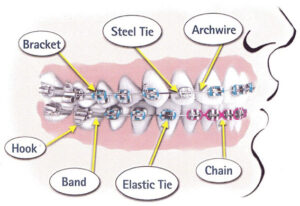Braces
 Straightening Smiles and Enhancing Oral Health
Straightening Smiles and Enhancing Oral Health
Braces are orthodontic devices designed to correct misaligned teeth and jaw discrepancies, providing patients with not only an improved aesthetic appearance but also enhanced oral health. Here’s a comprehensive overview of braces:
1. Types of Braces:
- Traditional Metal Braces: Consist of metal brackets attached to each tooth connected by wires. Colored bands can be added for a personalized touch.
- Ceramic Braces: Similar to metal braces but with tooth-colored or clear brackets, making them less noticeable.
- Lingual Braces: Placed on the inner surface of the teeth, these braces are virtually invisible from the outside.
- Invisalign (Clear Aligners): Custom-made, clear plastic trays that gradually move teeth into the desired position. They are removable for eating and oral hygiene.
2. Purpose of Braces:
- Malocclusion Correction: Braces address various orthodontic issues, including crooked teeth, crowded teeth, overbites, underbites, and crossbites.
- Enhanced Functionality: Properly aligned teeth contribute to better biting, chewing, and speaking.
- Prevention of Dental Issues: Orthodontic treatment helps prevent dental problems such as cavities, gum disease, and abnormal wear of tooth surfaces.
3. Braces Application Process:
- Consultation: A thorough examination, including X-rays, is conducted to assess the patient’s orthodontic needs.
- Treatment Plan: The orthodontist develops a customized treatment plan based on the diagnosis.
- Braces Placement: Brackets are attached to each tooth, and wires or aligners are adjusted to apply gentle pressure for tooth movement.
- Adjustments: Regular appointments are scheduled for adjustments to ensure the gradual and controlled movement of teeth.
4. Duration of Treatment:
- Varies by Case: The duration of orthodontic treatment with braces depends on the complexity of the case, ranging from several months to a few years.
- Compliance: Patient compliance with orthodontic instructions, such as wearing rubber bands or maintaining oral hygiene, can impact treatment duration.
5. Oral Care with Braces:
- Specialized Brushes: Orthodontic patients may use special brushes to clean around brackets and wires.
- Floss Threaders or Interdental Brushes: Tools to aid in flossing between wires and teeth.
- Regular Dental Check-ups: Monitoring oral health and addressing any issues promptly.
6. Adjustments and Discomfort:
- Periodic Adjustments: Orthodontic appointments involve adjustments to wire tension or aligner progression.
- Temporary Discomfort: Patients may experience mild discomfort or soreness after adjustments, which typically subsides within a few days.
7. Retention Phase:
- Retainers: After braces are removed, retainers are often prescribed to maintain the achieved alignment. They may be removable or fixed.
8. Impact on Lifestyle:
- Dietary Considerations: Certain foods, especially hard or sticky ones, may need to be avoided during orthodontic treatment.
- Sports and Activities: Mouthguards may be recommended for certain activities to protect the braces and the teeth.
9. Advancements in Orthodontics:
- Technological Innovations: Digital imaging, 3D modeling, and computer-aided design have enhanced treatment planning and precision.
Braces have become a common and effective solution for correcting orthodontic issues, transforming smiles and contributing to improved oral health. If you are considering braces or orthodontic treatment, consult with an orthodontic professional to discuss your specific needs and explore the most suitable options for achieving a straighter and healthier smile.
